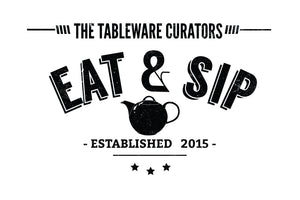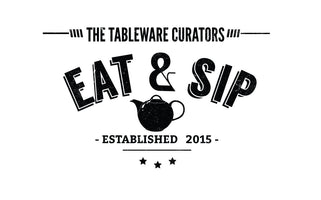
When we were looking for Singapore-based makers for our Open Studio 2019, we turned to our favourite discovery app, Instagram, to cast a wider net for possible collaborations. The wonderful algorithm led us to New Zealander Carragh Amos who had just shifted to Singapore a couple of months prior!

Her feed of wood-fired wares and kurinuki cups caught our attention as it was quite uncommon among the other local ceramicists. A couple of direct messages (DMs) later, we managed to convince her to participate in our little Open Studio and shot some questions at her at the same time.
Kurinuki is a Japanese term relating to a particular hand-forming technique which involves the hollowing out of solid clay form by carving.
 Some of her pieces at our Open Studio last year
Some of her pieces at our Open Studio last year
Let’s get straight into it - your kurinuki pieces gained quite a bit of attention during our Open Studio last year. Is it safe to say that you love hand-building more than wheel-throwing?
Yes, definitely. Hand-built ceramics are often even more time consuming than wheel thrown pieces, but I love that it forces me to work slowly and mindfully. I use slab building, pinching, carving (kurinuki style) and coil building techniques.
Most of my recent pieces are white/gold Australian raku clays which are electric fired to cone 6, and recent wood-fired works are high fire stoneware (LGH) hitting cone 11 in the Anagama.
 A slab and coil built vase that is anagama wood-fired for 51 hours.
A slab and coil built vase that is anagama wood-fired for 51 hours.
 An (unglazed) aquagama-fired kurinuki cup that was fired for 80+ hours at 1350°C!
An (unglazed) aquagama-fired kurinuki cup that was fired for 80+ hours at 1350°C!
Your style is very distinctive, more so in Singapore. How did your start with ceramics came about?
Growing up my parents were always appreciative of pottery so our family was often popping in to local galleries around New Zealand. I admired these potters, and had my first real taste of ceramics at a community night-class when I was a teenager. After high school I chose to pursue a BFA Honours in fine arts and experimented with clay in my third and fourth years, leading to a final handmade ceramic installation and thesis on Handmade Aesthetics.
 Don't you just love this set of torn plate and bowl?
Don't you just love this set of torn plate and bowl?
What do you like so much about pottery and is this your full-time job?
I find the process of making almost meditative and I love that handmade ceramics can be both therapeutic to make, and therapeutic to use. Making and engaging with ceramics is so intrinsic to being human, and it feels very natural to work with clay. We’ve been making pots for thousands of years! It’s amazing to be a part of this history.
 These four kurinuki tea/sake cups were carved on the exterior with a serrated knife.
These four kurinuki tea/sake cups were carved on the exterior with a serrated knife.
And yes, it sure is my full-time job. I split my time between functional and sculptural ware, research, writing exhibition proposals and various submissions, small business tasks and writing for my ceramics blog too (The Humble Mud).
What’s a dominant principle behind your ceramic work?
An important thing for me is to design ceramics that bring the rawness of nature into our homes and still maintain a simple elegance. My work is inspired by a wide range of influences including travel, archaeology, and Japanese antiques.
Recently I've been reading The Beauty Of Everyday Things by Soetsu Yanagi, which has inspired me to think a lot more about the way I balance detail and simplicity in an object.
 A wood-fired pom vase that went off to a new home.
A wood-fired pom vase that went off to a new home.
 A snapshot of her carving out process
A snapshot of her carving out process
During the creative process, some artists will pencil out the designs first while some love an unscripted approach.
For me, if I’ve been turning over an idea in my mind, I'll often sketch out simple line drawings to guide me while I'm working. But, I also like to build new designs by working intuitively and allowing one move to guide the next. If i’m happy with that piece, I'll then use it as the prototype for later forms.
 A freshly carved kurinuki tea cup. See here for the timelapse of the carving process.
A freshly carved kurinuki tea cup. See here for the timelapse of the carving process.
Pieces carved in the kurinuki style evolve naturally as I work away at a single ball of clay. When carving in this way, it feels very sculptural and I always find myself thinking about this quote from Michelangelo while I work -
“The sculpture is already complete within the marble block, before I start my work. It is already there, I just have to chisel away the superfluous material.”

Do you follow any other ceramicists closely?
There are so many fantastic contemporary artists to be inspired by. I love the earthy forms of Pavel Zhuravlev, silhouettes of Mitch Iburg and the iconic vessels of Jessica Coates. I'm also learning a lot about wood-firing techniques this year thanks to the generosity of Singapore-based potter Abraham Ling.
 A peek at what really goes on during the firing process!
A peek at what really goes on during the firing process!
Functional or decorative?
The line between art and craft is hazy, and it's really subjective. I’m interested in this idea of the everyday being decorative and vice versa. Why should they be one or the other? Why should they be both? There are no rules in our own homes.
 Her sphere vases in four different finishes!
Her sphere vases in four different finishes!
"I like to make pieces that are interesting to look at even when empty. Most of my current work sits somewhere between sculpture and functional craft."
We have heard from other makers that pottery is a long process and can be exasperating at times.
To be honest, the most frustrating aspect of clay work is the random probability of chance and failure. You definitely need some patience to work with ceramics. So much can go wrong at every stage, and sometimes you just have no idea why something has a giant crack through it or the glaze came out the wrong shade. There’s a lot of trial and error.
 This rusty-looking sphere vase is a good case in point!
This rusty-looking sphere vase is a good case in point!Pottery seems to be an in-trend activity nowadays. Why do you think this is so?
It feels good to slow down for a minute and use our hands - to reconnect with nature. I think creativity has been lost in so many careers and pottery has a way of connecting us to the present, whether through taking classes or using pottery crafted by others.
 Locally foraged clay from freshly dug to unfired greenware.
Locally foraged clay from freshly dug to unfired greenware.
More Singaporeans are aware of the value of a handmade product now as compared to, say, 5 years ago, but there are still some who can’t understand paying $30-40 for a handmade mug. How would you convince them?
I think that some people don’t realise the amount of time and work that goes into a handmade item. It takes 15+ steps to make a hand built mug! All this considered, the mug is an incredibly affordable piece of art.

It’s grounding to think of who made your mug and feel connected to the story behind it. We handle this object daily and many people are realising using a mass-produced item doesn't actually feel very good - there’s no value in the experience.
Finding joy in small moments and being mindful during everyday experiences is an opportunity to add so much pleasure to life.
 Hand-built and carved star-footed mugs. Due to the intuitive and spontaneity of the carving method, no two pieces are alike.
Hand-built and carved star-footed mugs. Due to the intuitive and spontaneity of the carving method, no two pieces are alike.
Any last words for budding ceramicists?
Don't be afraid to start, find your people and seek out a mentor! Get inspiration from places other than ceramics, and don’t forget that your work doesn't have to look like anyone else’s!
---
We are stocking some of Carragh's tea-cups for a limited time. Browse through them here! Otherwise, enjoy the rest of the snaps of her work below:
 A 55cm coil-built vase with slip applied on it.
A 55cm coil-built vase with slip applied on it.
 Love the texture of this slip!
Love the texture of this slip!
 Obviously, we have to show off her potter's mark!
Obviously, we have to show off her potter's mark!
 Footed pinch pots
Footed pinch pots
 And of course, every potter will definitely have their own personal ware! Featuring her own personal handmade bowl.
And of course, every potter will definitely have their own personal ware! Featuring her own personal handmade bowl.
 One of our favourite pieces from our Open Studio last year, it is completely unglazed, except for the orange swab. We love how the ash in the anagama kiln settled onto the tumbler giving it a variety of colours.
One of our favourite pieces from our Open Studio last year, it is completely unglazed, except for the orange swab. We love how the ash in the anagama kiln settled onto the tumbler giving it a variety of colours.
 Kurinuki teapot - we know where we'd get a tea pot from when we get our own house.
Kurinuki teapot - we know where we'd get a tea pot from when we get our own house.
 Love the bottom of these cups!
Love the bottom of these cups!
P.S All photos used in this article were taken by Carragh.


Leave a comment